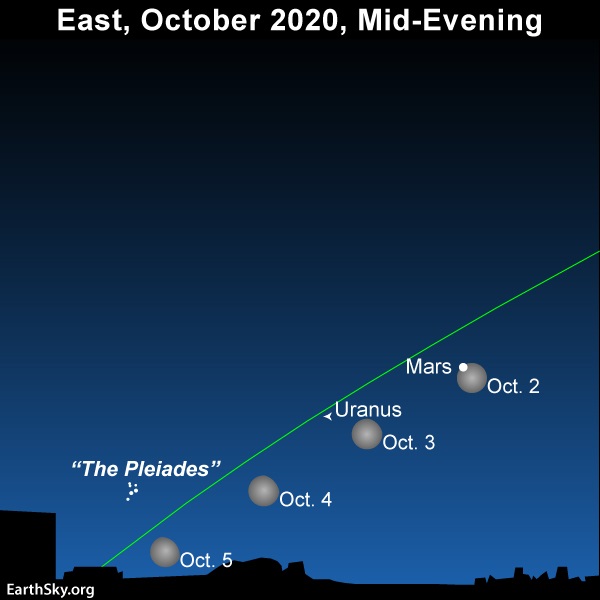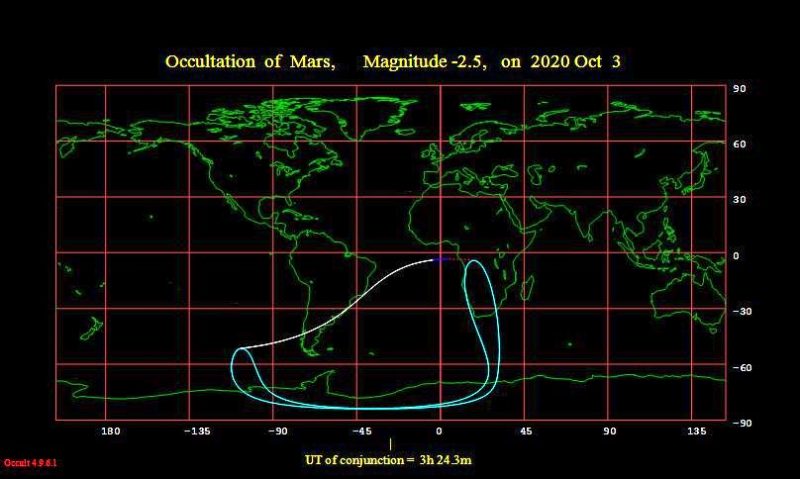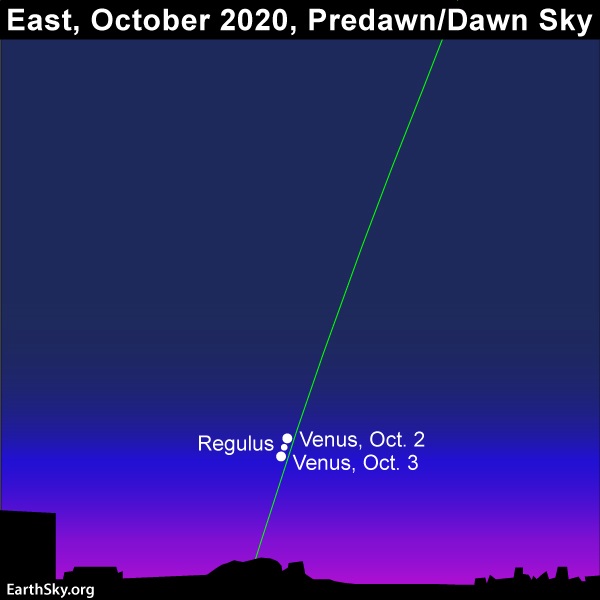
Photo above: Close encounter between the moon and Mars on July 17, 2003, captured by Andrew Chaikin in central Florida. Image via Andrew Chaikin/ SkyandTelescope.com.
In early October 2020, the waning gibbous moon – now just a day past its legendary Harvest Moon fullness – meets with the dazzling red planet Mars. On October 2, look for the glorious evening couple – the moon and Mars – to rise in tandem in your eastern sky around nightfall or early evening. After the brilliant twosome rises, they’ll be out for the rest of the night, traveling westward across the dome of night. The moon and Mars climb highest up for the night after midnight, and then sit low in the west as dawn starts to color the eastern horizon on October 3. If you’re at just the right place in South America on the night of October 2-3, you can watch the moon occult (cover over) Mars.
Look below for more details on this occultation.
Why is Mars so bright now? Earth will pass between Mars and the sun on October 13. Thus Mars is closer to us than it has been for this two-year period. You can’t miss Mars as the fiery red object ascending in the east each evening, near the moon on October 2.
If you’re in South America, and you see the moon but not Mars, that’ll be because Mars is behind the moon!

The moon will move away from Mars to pass to the south of the planet Uranus, and then to the south of the Pleiades star cluster. Most people need binoculars and a moon-free night to see Uranus. Use Mars and a sky chart to help you find Uranus when the moon has left the evening sky. Note: The moon looks larger on the chart than in the real sky.
Occultation of Mars by the moon. The farther north you live on the Earth’s surface, the farther south the moon swings from Mars; and the farther south you live, the closer the moon comes to Mars. In fact, if you live in southern South America, you can actually watch the moon occult (cover over) Mars for a portion of the night of October 2-3, 2020. For example from Santa Cruz, Argentina, Mars will disappear behind the moon on October 2, 2020, at 11:18 p.m. local Argentina Time, and Mars will reappear from behind the moon on October 3, 2020, at 12:18 a.m.
Speaking for Earth as a whole, as the moon makes its monthly rounds in front of the constellations of the zodiac, it sweeps 0.7 degrees south of Mars on October 3, at 03:21 Universal Time. At U.S. time zones, that converts to October 2, at 11:21 p.m. EDT, 10:21 p.m. CDT, 9:21 p.m. MDT and 8:21 p.m. PDT. Translate UTC to your time.
For reference, the moon’s angular diameter spans about 1/2 degree (0.5 degrees). But when an astronomical almanac gives the angular distance between the moon and a planet, it really means the angular distance between the center of the moon and that planet as viewed from the center of the Earth. For the Earth’s surface, the angular separation of the moon will be greater at some places yet less at others.

The swath of the world to the south (below) the white curve (southern South America, Falkland Islands) can see the lunar occultation of Mars on the night of October 2-3, 2020. Visit lunar-occultations.com for occultation times in Universal Time (UTC). You must convert UTC to local time. Here’s how. Worldwide map via IOTA.
About Mars in October 2020. As Earth prepares to sweep between Mars and the sun on October 13 – bringing Mars to its once-in-two-years opposition in our sky – Mars beams brilliantly in our sky. It’s brighter this month than it will for nearly another 15 years, until September 2035. The brilliant moon won’t be able to subdue this planet’s luster, as Mars (in October 2020) ranks as the fourth-brightest heavenly body in all the heavens, after the sun, moon and the planet Venus, respectively. It won’t be until November 2020 that the king planet Jupiter will reclaim its status as second-brightest planet and third-brightest object in the heavens. Read more: Mars to reach opposition on October 13.
There’s no way to mistake Venus for Mars, as Venus is only visible as a morning “star” in the eastern predawn/dawn sky. If you’re an early riser, up before daybreak, note where Mars sits low in the October morning sky. Then turn about-face, and you can’t miss Venus, by far the most brilliant starlike object in the sky.
By the way, if you’re up before dawn on October 2 or 3, look for Venus’ rendezvous with Regulus, the brightest star in the constellation Leo the Lion.

From North America, Venus appears about 1/2 degree to the west of (or above) Regulus on October 2, and about 1/2 degree east of (or below) Regulus on October 3. Conjunction comes on October 3, at 00:00 UTC, at which time Venus passes 0.1 degree south of Regulus. Read more.

View at EarthSky Community Photos. | Barry Medlin in Hahira, Georgia, caught Venus and Regulus on the morning of October 1, 2020. These 2 bodies – the planet and the star – won’t appear together in this way again for another 8 years. Thank you, Barry!
Bottom line: The moon and Mars are near each other on the sky’s dome on the night of October 2, 2020. From South America, the moon will appear to occult (cover over) Mars.
from EarthSky https://ift.tt/34dvxpm

Photo above: Close encounter between the moon and Mars on July 17, 2003, captured by Andrew Chaikin in central Florida. Image via Andrew Chaikin/ SkyandTelescope.com.
In early October 2020, the waning gibbous moon – now just a day past its legendary Harvest Moon fullness – meets with the dazzling red planet Mars. On October 2, look for the glorious evening couple – the moon and Mars – to rise in tandem in your eastern sky around nightfall or early evening. After the brilliant twosome rises, they’ll be out for the rest of the night, traveling westward across the dome of night. The moon and Mars climb highest up for the night after midnight, and then sit low in the west as dawn starts to color the eastern horizon on October 3. If you’re at just the right place in South America on the night of October 2-3, you can watch the moon occult (cover over) Mars.
Look below for more details on this occultation.
Why is Mars so bright now? Earth will pass between Mars and the sun on October 13. Thus Mars is closer to us than it has been for this two-year period. You can’t miss Mars as the fiery red object ascending in the east each evening, near the moon on October 2.
If you’re in South America, and you see the moon but not Mars, that’ll be because Mars is behind the moon!

The moon will move away from Mars to pass to the south of the planet Uranus, and then to the south of the Pleiades star cluster. Most people need binoculars and a moon-free night to see Uranus. Use Mars and a sky chart to help you find Uranus when the moon has left the evening sky. Note: The moon looks larger on the chart than in the real sky.
Occultation of Mars by the moon. The farther north you live on the Earth’s surface, the farther south the moon swings from Mars; and the farther south you live, the closer the moon comes to Mars. In fact, if you live in southern South America, you can actually watch the moon occult (cover over) Mars for a portion of the night of October 2-3, 2020. For example from Santa Cruz, Argentina, Mars will disappear behind the moon on October 2, 2020, at 11:18 p.m. local Argentina Time, and Mars will reappear from behind the moon on October 3, 2020, at 12:18 a.m.
Speaking for Earth as a whole, as the moon makes its monthly rounds in front of the constellations of the zodiac, it sweeps 0.7 degrees south of Mars on October 3, at 03:21 Universal Time. At U.S. time zones, that converts to October 2, at 11:21 p.m. EDT, 10:21 p.m. CDT, 9:21 p.m. MDT and 8:21 p.m. PDT. Translate UTC to your time.
For reference, the moon’s angular diameter spans about 1/2 degree (0.5 degrees). But when an astronomical almanac gives the angular distance between the moon and a planet, it really means the angular distance between the center of the moon and that planet as viewed from the center of the Earth. For the Earth’s surface, the angular separation of the moon will be greater at some places yet less at others.

The swath of the world to the south (below) the white curve (southern South America, Falkland Islands) can see the lunar occultation of Mars on the night of October 2-3, 2020. Visit lunar-occultations.com for occultation times in Universal Time (UTC). You must convert UTC to local time. Here’s how. Worldwide map via IOTA.
About Mars in October 2020. As Earth prepares to sweep between Mars and the sun on October 13 – bringing Mars to its once-in-two-years opposition in our sky – Mars beams brilliantly in our sky. It’s brighter this month than it will for nearly another 15 years, until September 2035. The brilliant moon won’t be able to subdue this planet’s luster, as Mars (in October 2020) ranks as the fourth-brightest heavenly body in all the heavens, after the sun, moon and the planet Venus, respectively. It won’t be until November 2020 that the king planet Jupiter will reclaim its status as second-brightest planet and third-brightest object in the heavens. Read more: Mars to reach opposition on October 13.
There’s no way to mistake Venus for Mars, as Venus is only visible as a morning “star” in the eastern predawn/dawn sky. If you’re an early riser, up before daybreak, note where Mars sits low in the October morning sky. Then turn about-face, and you can’t miss Venus, by far the most brilliant starlike object in the sky.
By the way, if you’re up before dawn on October 2 or 3, look for Venus’ rendezvous with Regulus, the brightest star in the constellation Leo the Lion.

From North America, Venus appears about 1/2 degree to the west of (or above) Regulus on October 2, and about 1/2 degree east of (or below) Regulus on October 3. Conjunction comes on October 3, at 00:00 UTC, at which time Venus passes 0.1 degree south of Regulus. Read more.

View at EarthSky Community Photos. | Barry Medlin in Hahira, Georgia, caught Venus and Regulus on the morning of October 1, 2020. These 2 bodies – the planet and the star – won’t appear together in this way again for another 8 years. Thank you, Barry!
Bottom line: The moon and Mars are near each other on the sky’s dome on the night of October 2, 2020. From South America, the moon will appear to occult (cover over) Mars.
from EarthSky https://ift.tt/34dvxpm

Aucun commentaire:
Enregistrer un commentaire